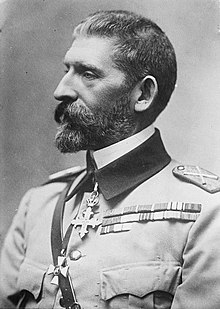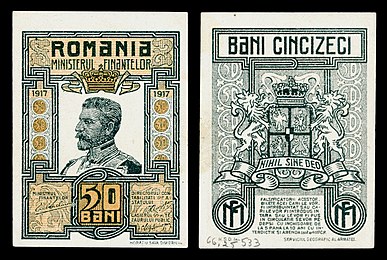Ferdinand I of Romania
| Ferdinand I | |||||
|---|---|---|---|---|---|
 Ferdinand in the 1920s | |||||
| King of Romania | |||||
| Reign | 10 October 1914 – 20 July 1927 | ||||
| Coronation | 15 October 1922 | ||||
| Predecessor | Carol I | ||||
| Successor | Michael I | ||||
| Born | 24 August 1865 Sigmaringen Castle, Sigmaringen, German Confederation | ||||
| Died | 20 July 1927 (aged 61) Peleș Castle, Sinaia, Kingdom of Romania | ||||
| Burial | Curtea de Argeș, Romania | ||||
| Spouse |
Marie of Edinburgh (m. 1893) | ||||
| Issue |
| ||||
| |||||
| House | Hohenzollern-Sigmaringen | ||||
| Father | Leopold, Prince of Hohenzollern | ||||
| Mother | Infanta Antónia of Portugal | ||||
| Religion | Catholic Church | ||||
Ferdinand I (Ferdinand Viktor Albert Meinrad; 24 August 1865 – 20 July 1927), nicknamed Întregitorul ("the Unifier"), was King of Romania from 1914 until his death in 1927. Ferdinand was the second son of Leopold, Prince of Hohenzollern, and Infanta Antónia of Portugal, daughter of Ferdinand II of Portugal and Maria II of Portugal. His family was part of the Catholic branch of the Prussian royal family Hohenzollern.
In 1889, Ferdinand became Crown Prince of the
Ferdinand became
Ferdinand died from cancer in 1927 and was succeeded by his grandson Michael under a regency formed by three people:
Early life

Prince Ferdinand Viktor Albert Meinrad of Hohenzollern-Sigmaringen was born in Sigmaringen in southwestern Germany. The name was later shortened simply to Hohenzollern after the extinction of the Hohenzollern-Hechingen branch in 1869. The princes of Hohenzollern-Sigmaringen had ruled the principality until 1850, when it was annexed to Prussia.
Ferdinand I was the son of
Following the renunciations, first of his father in 1880 and then of his elder brother
Ferdinand's mother's first cousin Tsar
Ferdinand, a complete stranger in his new home, started to get close to one of Queen Elisabeth's ladies in waiting, Elena Văcărescu. Elisabeth, the Queen consort of Romania, very close to Elena herself, encouraged the romance, although she was perfectly aware of the fact that a marriage between the two was forbidden by the Romanian constitution (according to the 1866 Constitution of Romania, the heir-presumptive to the throne was not allowed to marry a Romanian).
The affair caused a sort of dynastic crisis in 1891. The result of this was the exile of both Elisabeth (in Neuwied) and Elena (in Paris), as well as a trip by Ferdinand through Europe in search of a suitable bride, whom he eventually found in Queen Victoria's granddaughter, Princess Marie of Edinburgh.
Marriage

In Sigmaringen on 10 January 1893, Prince Ferdinand of Romania married his distant cousin, the
The royal Romanian marriage produced three sons (Carol, Nicholas, and Mircea – the last of whom died in infancy) and three daughters (Elisabeta, Maria – called "Mignon" – and Ileana), but it was unhappy. Indeed, the couple's two youngest children, Ileana and Mircea, are widely believed to have been sired by Marie's long-time lover, Barbu Știrbey.[3][4]
King of Romania
On 10 October 1914, Ferdinand's uncle, Carol I, died without surviving issue. Ferdinand succeeded him as King of Romania, reigning until his own death on 20 July 1927.
Ferdinand was appointed as the 1,174th Knight of the Order of the Golden Fleece in Austria in 1909 and as the 868th Knight of the Order of the Garter in 1924.
World War I
Though a member of a cadet branch of Germany's ruling Hohenzollern imperial family, Ferdinand presided over his country's entry into World War I on the side of the Triple Entente against the Central Powers, on 27 August 1916. Thus he gained the sobriquet "the Loyal", having kept the oath he swore before the Romanian Parliament in 1914: "I will reign as a good Romanian."

As a consequence of this "betrayal" of his German origin,
Despite the setbacks after the entry into war, when
The outcome of Romania's war effort was the union of
A new period of Romanian history began on the day of the Union of Transylvania with Romania (Great Union Day, Marea Unire).[5] This period would come to an end with international treaties, in the years leading to World War II, which ceded parts of Romania to its neighbors. As such, they are widely seen as an attempt to provoke the country into taking sides and joining the war.[6][7][8]
After the war
Domestic political life during his reign was dominated by the conservative National Liberal Party, which was led by the brothers Ion and Vintilă Brătianu. The acquisition of Transylvania had the unintended effect of enlarging the electoral base of the opposition, whose principal parties united in January 1925 – October 1926 to form the National Peasant Party.
Death

Ferdinand died from cancer in Sinaia in 1927, and was succeeded by his grandson Michael under a regency (King Michael's father having renounced his rights to the throne in December 1925). The regency had three members, one of whom was Ferdinand's second son, Prince Nicholas.
Honours
He received the following honours:[9]
 Romania:
Romania:
- Grand Cross of the Star of Romania
- Grand Cross of the Crown of Romania
- Grand Cross of the Order of Carol I, with Collar, 1906[10]
- Founder of the Order of Michael the Brave, 26 September 1916
- Hohenzollern: Cross of Honour of the Princely House Order of Hohenzollern, 1st Class
 Kingdom of Prussia:
Kingdom of Prussia:
- Knight of the Black Eagle, 10 January 1893;[11] with Collar
- Grand Cross of the Red Eagle, with Swords
 Duchy of Anhalt: Grand Cross of the Order of Albert the Bear, 1887[12]
Duchy of Anhalt: Grand Cross of the Order of Albert the Bear, 1887[12] Knight of St. Hubert, 1908[13]
Knight of St. Hubert, 1908[13]

 Ernestine duchies: Grand Cross of the Saxe-Ernestine House Order
Ernestine duchies: Grand Cross of the Saxe-Ernestine House Order Grand Duchy of Hesse: Grand Cross of the Ludwig Order, 19 April 1894[14]
Grand Duchy of Hesse: Grand Cross of the Ludwig Order, 19 April 1894[14] Kingdom of Saxony: Knight of the Rue Crown[15]
Kingdom of Saxony: Knight of the Rue Crown[15]
 Austria-Hungary:[16]
Austria-Hungary:[16]
- Grand Cross of the Royal Hungarian Order of St. Stephen, 1890
- Knight of the Golden Fleece, 1909
- Grand Cross of the
 Belgium: Grand Cordon of the Order of Leopold
Belgium: Grand Cordon of the Order of Leopold Grand Cross of St. Alexander
Grand Cross of St. Alexander Czechoslovakia: Collar of the White Lion, 1925[17]
Czechoslovakia: Collar of the White Lion, 1925[17] Denmark: Knight of the Elephant, 8 January 1908[18]
Denmark: Knight of the Elephant, 8 January 1908[18] France: Grand Cross of the Legion of Honour
France: Grand Cross of the Legion of Honour Greece: Grand Cross of the Redeemer
Greece: Grand Cross of the Redeemer Italy: Knight of the Annunciation, 30 January 1893[19]
Italy: Knight of the Annunciation, 30 January 1893[19] Sovereign Military Order of Malta: Knight of Honour and Devotion[20]
Sovereign Military Order of Malta: Knight of Honour and Devotion[20] Montenegro: Grand Cross of the Order of Prince Danilo I
Montenegro: Grand Cross of the Order of Prince Danilo I Netherlands: Grand Cross of the Netherlands Lion
Netherlands: Grand Cross of the Netherlands Lion Poland:
Poland:
- Knight of the White Eagle, 31 August 1921
- Grand Cross of the Virtuti Militari, with Star, 21 June 1923[21]
- Portugal:
 Kingdom of Portugal: Grand Cross of the Sash of the Two Orders
Kingdom of Portugal: Grand Cross of the Sash of the Two Orders Grand Cross of the Tower and Sword, 11 May 1921[22]
Grand Cross of the Tower and Sword, 11 May 1921[22]
 Russia:
Russia:
- Knight of St. Andrew, 1894[15]
- Knight of St. Alexander Nevsky
- Knight of the White Eagle
- Knight of St. Anna, 1st Class
- Knight of St. Stanislaus, 1st Class
- Knight of St. George, 2nd Class, 15 March 1918
 Serbia:[23]
Serbia:[23]
- Grand Cross of the White Eagle
- Grand Cross of the Star of Karađorđe, with Swords
 Knight of the Seraphim, 18 December 1907[24]
Knight of the Seraphim, 18 December 1907[24] United Kingdom:
United Kingdom:
- Honorary Grand Cross of the Bath (civil), 21 December 1892[25]
- Stranger Knight Companion of the Garter, 14 May 1924
- Royal Victorian Chain
- Honorary Grand Cross of the Royal Victorian Order
Ancestry
| Ancestors of Ferdinand I of Romania | |||||||||||||||||||||||||||||||||||||||||||||||||||||||||||||||||||||||||||||||||||||||||||||||||||||
|---|---|---|---|---|---|---|---|---|---|---|---|---|---|---|---|---|---|---|---|---|---|---|---|---|---|---|---|---|---|---|---|---|---|---|---|---|---|---|---|---|---|---|---|---|---|---|---|---|---|---|---|---|---|---|---|---|---|---|---|---|---|---|---|---|---|---|---|---|---|---|---|---|---|---|---|---|---|---|---|---|---|---|---|---|---|---|---|---|---|---|---|---|---|---|---|---|---|---|---|---|---|
| |||||||||||||||||||||||||||||||||||||||||||||||||||||||||||||||||||||||||||||||||||||||||||||||||||||
References
- ^ "Ferdinand I". Retrieved 28 March 2013.
- ^ "The Royals: King Ferdinand I". Archived from the original on 4 May 2013. Retrieved 28 March 2013.
- ISBN 0-7553-1392-5.
- ISBN 0-297-78598-2.
- ^ "Marea Unire de la Alba Iulia – 1 Decembrie 1918". cimec.ro. Archived from the original on 18 March 2014. Retrieved 7 December 2014.
- ISBN 973-9175-24-4
- ISBN 9789739175241.
- ^ "King Ferdinand I". Retrieved 28 March 2013.
- ^ Hof- und Staats-Handbuch des Königreich Preußen (1908), Genealogy p.6
- ^ "Ordinul Carol I" [Order of Carol I]. Familia Regală a României (in Romanian). Bucharest. Retrieved 16 June 2020.
- ^ "Schwarzer Adler-orden", Königlich Preussische Ordensliste (supp.) (in German), vol. 1, Berlin, 1886, p. 5 – via hathitrust.org
{{citation}}: CS1 maint: location missing publisher (link) - ^ Hof- und Staats-Handbuch für des Herzogtum Anhalt (1894), "Herzoglicher Haus-Orden Albrecht des Bären" p. 17
- ^ Hof- und – Staatshandbuch des Königreichs Bayern (1909), "Königliche Orden". p. 9
- ^ "Ludewigs-orden", Großherzoglich Hessische Ordensliste (in German), Darmstadt: Staatsverlag, 1907, p. 8
- ^ a b Justus Perthes, Almanach de Gotha (1913) p. 78
- ^ "Ritter-Orden", Hof- und Staatshandbuch der Österreichisch-Ungarischen Monarchie (in German), 1910, pp. 56, 60, retrieved 3 April 2020
- ^ "Kolana Řádu Bílého lva aneb hlavy států v řetězech" (in Czech), Czech Medals and Orders Society. Retrieved 9 August 2018.
- ISBN 978-87-7674-434-2.
- ^ Italia : Ministero dell'interno (1898). Calendario generale del Regno d'Italia. Unione tipografico-editrice. p. 54.
- ^ "King Ferdinand I from the first visit in Country to his death | Only in Romania". only-romania.com. Retrieved 7 December 2014.
- ^ Stanisław Łoza (1935), "Virtuti Militari", Broń i Barwa (in Polish), Warsaw: Stowarzyszenie Przyjaciół Muzeum Wojska, p. 148
- ^ "Ordem Militar da Torre e Espada – Processos de Estrangeiros: Fernando I (Rei da Roménia)" (in Portuguese), Arquivo Histórico da Presidência da República. Retrieved 3 April 2020.
- ^ Acović, Dragomir (2012). Slava i čast: Odlikovanja među Srbima, Srbi među odlikovanjima. Belgrade: Službeni Glasnik. p. 368.
- ^ Svensk rikskalender (in Swedish), 1909, p. 613, retrieved 6 January 2018 – via runeberg.org
- ^ Shaw, Wm. A. (1906) The Knights of England, I, London, p. 214
- (in Romanian) Wolbe, Eugen:Ferdinand I – Întemeietorul României Mari (Ferdinand I, founder of Greater Romania), Humanitas, 2006.
External links
![]() Media related to Ferdinand I of Romania at Wikimedia Commons
Media related to Ferdinand I of Romania at Wikimedia Commons

